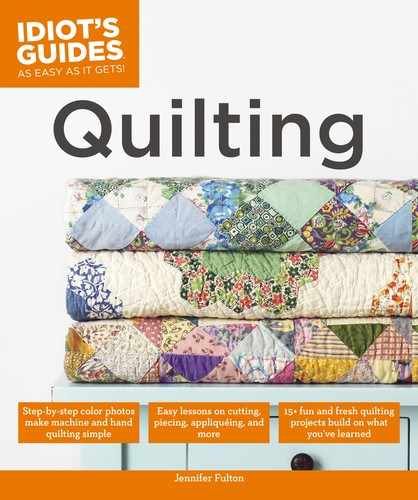
56
CHAPTER PIECING QUILT BLOCKS
Useful Hand Stitches
Even if you choose to machine-piece your quilt, there are times when you may work by hand, such as
when you’re stitching on the quilt binding, adding hanging sleeves and labels, or working with appli-
qué. Here are the stitches you need to know to perform such tasks by hand, along with a special knot
called the quilter’s knot.
To thread the needle, pull the thread off the spool and thread that leading end through the needle eye.
Cut the thread at about 18 inches (46 cm), and form the knot at this end, the end closest to the spool.
By maintaining the direction the thread comes off the spool, you maintain the thread’s natural twist
and reduce its tendency to form knots as you sew.
Quilter’s Knot
To form a quilter’s knot, hold the needle in your le
hand, and with your right, wrap the thread three times
around the needle. Pinch the wrapped thread against
the needle with your le hand. With your right hand,
pull the needle up. The wrapped thread will slide
down the thread as you continue to pinch it, closing
into a tight knot at the end.
Running Stitches
Running stitches are used in hand piecing. They are
small and even, on both the front and the back of the
fabric. To make a running stitch, weave your needle
in and out of the fabric three times at even intervals,
about
1
⁄
8
inch (3 mm) apart. Then pull the thread to
form three stitches. Straighten out any ruffles in the
fabric and continue.

57
USEFUL HAND STITCHES
Backstitch
When hand-piecing, you oen take a backstitch to
hold the thread, rather than using a knot. Bring the
needle up from the back at point A. Bring the needle
down to the right, at point B. Bring the needle up a bit
to the le, at point C and then down again at point D.
Whipstitch
Whipstitches are used to sew together blocks in
English paper-piecing. Bring the needle through from
the back near the block edges, wrapping it around to
the back again for the next stitch. Place stitches close
together.
Appliqué Stitch
Appliqué stitches (also called blind stitches) are
almost hidden, making them perfect for hand appli-
qué. Start by bringing the needle up at a point very
near the edge of the appliqué or binding, just catching
it. Come down into the background fabric, directly
across from the point where you came up. Bring the
needle back up again, about
1
⁄
8
inch (3 mm) to the le,
and repeat.
Blanket Stitch
Blanket stitches are sometimes used to finish an appli-
qué edge. Bring the needle up through the appliqué
from the back, about
1
⁄
4
inch (.6 cm) away from the
appliqué edge. Wrap the thread to the back, and come
up again about
1
⁄
4
inch (.6 cm) to the le. As you bring
the needle through, catch it within the thread loop.
Pull gently to tighten the stitch and then repeat the
stitch.
AB
C
D
A
B
C
..................Content has been hidden....................
You can't read the all page of ebook, please click here login for view all page.
